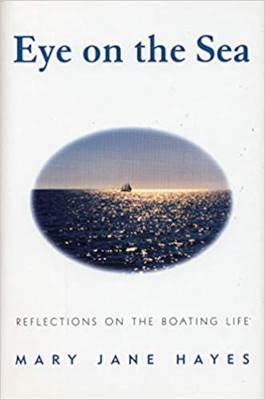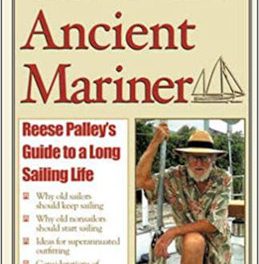
Readers of Good Old Boat know Mary Jane Hayes as one who captures the beauty of boating eloquently in vibrant pictures. We print these photos to remind ourselves why we’re doing all this work on our good old boats. But there’s more to Mary Jane than our readers have had a chance to see. What she can see with her eyes and record on film, Mary Jane can also describe in words that sing paeans of praise for the love of the sea.
In her new book, Eye on the Sea: Reflections on the Boating Life, set for publication in April, Mary Jane writes about her perceptions with a prose both poetic and descriptive. In describing the best things in boating she paints a scene as vivid as any of her photos.
Among my gifts from the sea: Windfilled rushes twinkling dryly . . . a bone-white beach . . . one sail slipping into the horizon . . . any of those charming little towns founded on the sea, whose streets slope steeply down to the water . . . wakes wide as bridal trains and waves curving neatly away from a bow . . . spinnakers like puff pastries . . . dinghies following sailboats like faithful household pets . . . flemished lines . . . a hatch full of stars . . .
You cannot always sail at the best of times, and Mary Jane gives equal time to the character- and experience-building moments we’d all prefer to put behind us.
Wham!!! It struck like that, a west wind of 35 knots without warning and almost knocking us down. “Get down the main! Quick!” my husband exclaimed. I lumbered forward as fast as my cumbersome foul weather gear would permit and hauled it down. “Take your time. Take your time,” I whispered to myself, shaking a little – more from being startled than afraid – as I braced against the boom while I unscrewed the main’s halyard shackle. “Unscrew it straight so it won’t wedge stuck,” (as it can at certain angles) I counseled myself. Naturally it jammed. “I can’t do it!” I cried, aware before the words were out that I had to. “Of course you can,” insisted the skipper encouragingly. Shutting the tumult out with a deliberate effort, I concentrated on the task. “Now for goodness sake, don’t let it go!” I warned myself, hanging onto the shackle for all I was worth as I ducked under a canvas flapping so rudely I hoped it wouldn’t knock me overboard and took the shackle to the lifeline to secure it. Lose the main halyard in a wind like that and all kinds of disastrous mischief would result! “From now on,” I pronounced, as I scrambled back to the shelter of the cockpit and took the helm so that Warren could furl and tie the main, “we’re going to wear our harnesses when it blows up!” . . . Within minutes we were experiencing gusts to 40 and then to 45 and 50, and almost in disbelief, had switched our anemometer to its highest gauge. In an hour and a half we had gone from a flat calm to a fresh gale.
The chapters in this book are short and unconnected, so reading can be done for inspiration – one short bit at a time in much the same way that people read daily meditation journals. It just might be the right book to have below decks when you’re recovering from one of those onboard character-building experiences. Having the book at hand may help you or members of your crew remember why you’re all out there in the first place.
Where others capture images in words or pictures, Mary Jane is capable of doing both. This rare ability gives her a very special “eye on the sea.” Her book by the same name allows her to share her observations with the rest of us who are not blessed with this gift.
Eye On the Sea by Mary Jane Hayes ( Breakaway Books, 1999)




